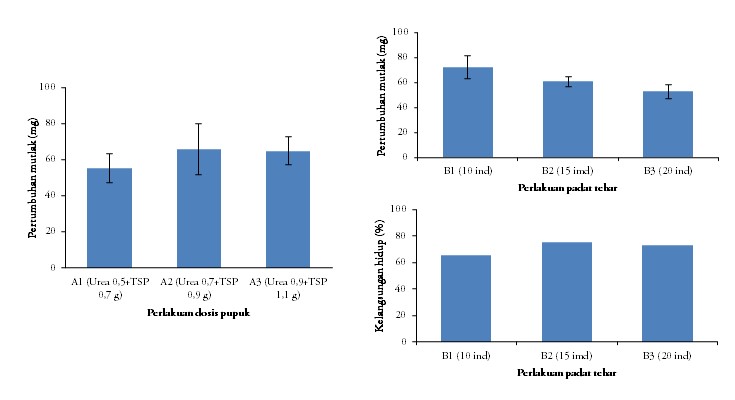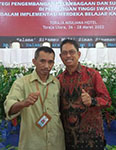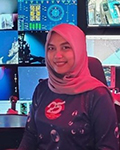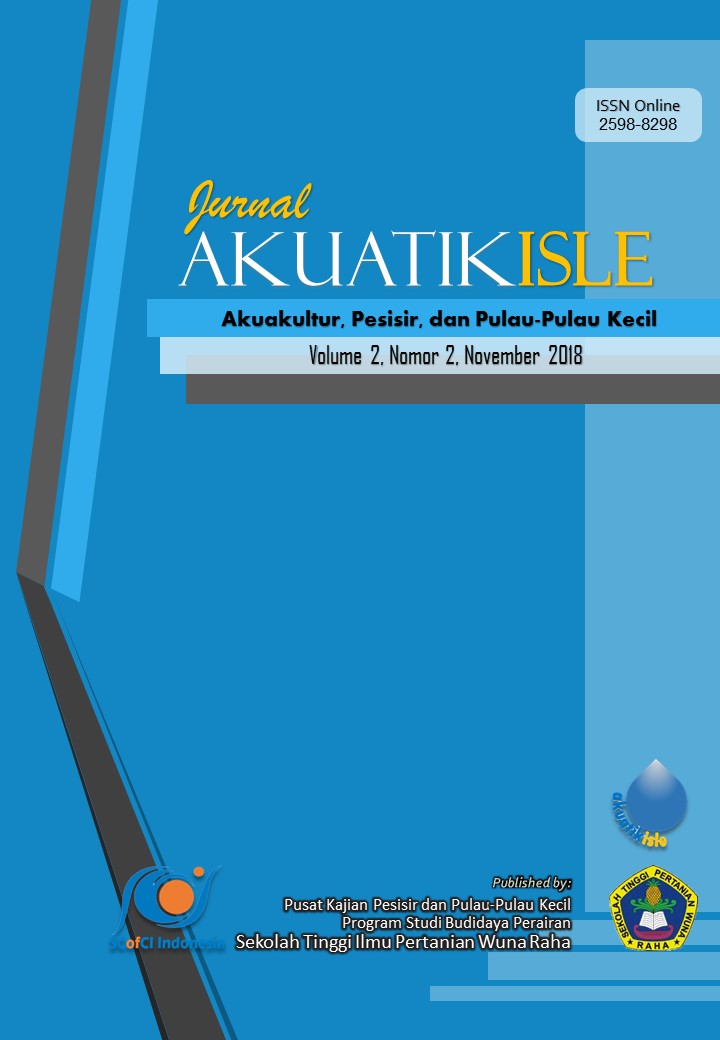Akuatikisle: Jurnal Akuakultur, Pesisir dan Pulau-Pulau Kecil
Full Length Article
Growth and survival rate vannamei shrimp (Litopenaeus vannamei) in various doses of fertilizer and density
Highlights
Generate NLP AI by Wizdam ID.
Abstract
Vannamei shrimp (Litopenaeus vannamei) is a commodity that is expected to not only increase options for farmers but also sustain the rise of shrimp farming business in Indonesia. One important factor in shrimp farming is the availability of feed. In addition to the availability of natural feed during cultivation, stocking density is also very influential in the survival rate and growth of shrimp vannamei. The research was conducted in September-December 2016 farms Bonea Village District of Lasalepa Muna with Test the different dosages with different stocking density. The study used a Random Group Factorial, which is based fertilization (Factor A) with three levels and stocking density (Factor B) as many as three levels, each with three replications so that all 27 units experimental unit. The results showed that the combination of factors dose of 0.7 g of urea + 0.9 g TSP and stocking density factor of 10 individuals per container provides prawn post larvae growth vannamei most excellent and a combination of factors Urea fertilizer dosage of 0.9 g TSP + 1.1 g and stocking density factor of 20 individuals per container provides a survival rate of post larvae vannamei most good. Water quality media for research in the range that is optimal for the growth and survival of post larvae vannamei.
Keywords
Introduction
Section snippets
Material and Methods
Materials and methods from the full-text PDF of this article cannot be displayed.
Results
Results from the full-text PDF of this article cannot be displayed.
Discussion
Discussion from the full-text PDF of this article cannot be displayed.
Conclusions
Conclusions from the full-text PDF of this article cannot be displayed.
Acknowledgment
Acknowledgment from the full-text PDF of this article cannot be displayed.
Funding Information
Kementerian Riset, Teknologi, dan Pendidikan Tinggi
Competing interest
The authors declare that they have no known competing financial interests or personal relationships that could have appeared to influence the work reported in this paper.
Conflict of interest
The authors declare that the research was conducted in the absence of any commercial or financial relationships that could be construed as a potential conflict of interest.
Ethical approval acknowledgements
No ethical approval required for this article. All procedures followed were in accordance with the ethical standards of the responsible committee on human experimentation (institutional and national) and with the Helsinki Declaration of 1975, as revised in 2008 (5)
Supplementary files
Data sharing not applicable to this article as no datasets were generated or analysed during the current study, and/or contains supplementary material, which is available to authorized users.
References (1)
Abidin J., 2011. Penambahan Kalsium untuk Meningkatkan Kelangsungan Hidup dan Pertumbuhan Juvenil Udang Galah (Macrobrachium rosenbergii de Man) Pada Media Bersalinitas. Sekolah Pascasarjana Institut Pertanian Bogor. Bogor Indonesia.
Amri K., 2003. Budi Daya Udang Windu secara Intensif. AgroMedia.
Amri K., 2013. Budi Daya Udang Vaname. Gramedia Pustaka Utama.
Anonim 2011. Budidaya Udang Vaname (Littopenaeus vannamei). Pusat Penyuluhan Kelautan dan Perikanan. Jakarta, 53 p.
Asnawi & Mukhlis2008. Analisis ekspor udang Indonesia: Suatu Pendekatan VECM. In: Prosiding International Conference on Regional Networking 2008. pp. 27–28.
Boyd C.E., 1982. Water quality management for pond fish culture. cod. Water quality management for pond fish culture., Elsevier Scientific Publishing Co. Amsterdam, 318 p.
Boyd C.E., 1991. Water Quality and Aeration in Shrimp Farming, Aurbun University, Alabama. Birmingham Publishing Co. Birmingham, Alabama.
Budiardi T., Muzaki A., & Utomo N.B.P., 2005. Produksi udang vaname (Litopenaeus vannamei) di tambak biocrete dengan padat penebaran yang berbeda. J. Akuakultur Indonesia. 4(2):109–115.
Effendie M.I., 1997. Biologi Perikanan. Yayasan Pustaka Nusatama. Yogyakarta, 163 p.
Elovaara A.K., 2003. Shrimp Farming Manual: Practical Technology for Intensive Shrimp Production. United States of America, 220 p.
Engle C., 2006. Shrimp Culture. cod. China International Training Course on Technology of Marineculture (Precious Fishes). China: Yiamen Municipial Science & Technology Commission, 107–113 p.
Ernawati E., & Rochmady R., 2017. Effect of fertilization and density on the survival rate and growth of post-larva of shrimp vaname (Litopenaues vannamei). Akuatikisle: Jurnal Akuakultur, Pesisir dan Pulau-Pulau Kecil. 1(1):1–10. DOI: 10.29239/j.akuatikisle.1.1.1-10.
Fast A.W., & Lester L.J., 1992. Marine Shrimp Culture: Principles and Practices Development in Aquaculture and Fisheries Sciences. Fast A. W. & Lester L. J. (eds.), Volume 23 ed., vol. 7, cod. Developments in Aquaculture and Fisheries Science, Elsevier. Amsterdam, 349–361 p.
Fegan D.F., 2003. Budidaya Udang Vannamei (Litopenaeus vannamei) di Asia. cod. Gold Coin Indonesia Specialities Jakarta.
Fitriani F., Fendi F., & Rochmady R., 2017. Effect of inorganic fertilizer (NPK+Silicate) with different dosage to Skeletonema costatum density on hatchery of tiger shrimp. Akuatikisle: Jurnal Akuakultur, Pesisir dan Pulau-Pulau Kecil. 1(1):11–18. DOI: 10.29239/j.akuatikisle.1.1.11-18.
Gufana S.S.M., Fendi F., Karyawati K., & Sommeng A., 2017. Study of suitability waters location for seaweed culture in Muna Regency, Indonesia. Akuatikisle: Jurnal Akuakultur, Pesisir dan Pulau-Pulau Kecil. 1(2):13–24. DOI: 10.29239/j.akuatikisle.1.2.13-24.
Haliman R.W., & Adijaya D., 2005a. Udang vannamei, Pembudidayaan dan Prospek Pasar Udang Putih yang Tahan Penyakit. vol. 75, Penebar Swadaya. Jakarta, 1–75 p.
Haliman R.W., & Adijaya D.S., 2005b. Udang Vanname. Penebar Swadaya. Jakarta.
Harefa F., 1996. Pembudidayaan Artemia Untuk Pakan Udang dan Ikan. Penebar Swadaya. Jakarta.
Herawati V.E., & Hutabarat J., 2015. Analisis pertumbuhan; kelulushidupan dan produksi biomass larva udang vannamei dengan pemberian pakan Artemia sp. produk lokal yang diperkaya Chaetoceros calcitrans dan Skeletonema coctatum. Pena Akuatika: Jurnal Ilmiah Perikanan dan Kelautan. 12(1):1–12.
Nengsih E.A., 2015. Pengaruh aplikasi probiotik terhadap kualitas air dan pertumbuhan udang Litopenaeus vannamei. Jurnal Biosains. 1(1):11–16.
Praditia F.P., 2009. Pengaruh Pemberian Bakteri Probiotik Melalui Pakan terhadap Pertumbuhan dan Kelangsungan Hidup Udang Windu Penaeus monodon. Institut Pertanian Bogor, 52 p.
Purba C.Y., 2012. Performa pertumbuhan, kelulushidupan, dan kandungan nutrisi larva udang vanamei (Litopenaeus vannamei) melalui pemberian pakan artemia produk lokal yang diperkaya dengan sel diatom. Journal of Aquaculture Management and Technology. 1(1):102–115.
Rakhfid A., Baya N., Bakri M., & Fendi F., 2017a. Growth and survival rate of white shrimp (Litopenaeus vannamei) at different density. Akuatikisle: Jurnal Akuakultur, Pesisir dan Pulau-Pulau Kecil. 1(2):1–6. DOI: 10.29239/j.akuatikisle.1.2.1-6.
Rakhfid A., Harlianti H., Fendi F., & Karyawati K., 2017b. Growth and survival rate of vaname shrimp (Litopenaeus vannamei) at various doses of fertilizer. Akuatikisle: Jurnal Akuakultur, Pesisir dan Pulau-Pulau Kecil. 1(2):7–12. DOI: 10.29239/j.akuatikisle.1.2.7-12.
Ratnawati E., 2008. Budidaya udang windu (Penaeus monodon) sistem semi-intensif pada tambak tanah sulfat masam. Media Akuakultur. 3(1):6–10. DOI: 10.15578/ma.3.1.2008.6-10.
Saoud I.P., Davis D.A., & Rouse D.B., 2003. Suitability studies of inland well waters for Litopenaeus vannamei culture. Aquaculture. 217(1–4):373–383. DOI: 10.1016/S0044-8486(02)00418-0.
Sudaryono A., 2006. Kajian kontribusi pakan alami dan buatan serta variasi musim pada performansi pertumbuhan juvenil udang Penaeus monodon yang dipelihara dalam tambak air payau. Aquacultura Indonesiana. 7(2):85–91.
Susianingsih E., Atmomarsono M., & Kurniawan K., 2016. Aplikasi Probiotik Rica 4, 5, dan 3 pada Budidaya Udang Vaname di Tambak yang diaerasi menggunakan Blower Supercharge. In: Prosiding Forum Inovasi Teknologi Akuakultur 2016. vol. 1. pp. 867–876.
Suyanto S.R., & Mujiman A., 2004. Budidaya udang windu. Penebar Swadaya. Jakarta.
Taqwa F.H., 2008. Pengaruh Penambahan Kalium pada Masa Adaptasi Penurunan Salinitas terhadap Performa Pascalarva Udang Vannamei (Litopenaeus vannamei). Institut Pertanian Bogor, 84 p.
Usman A., & Rochmady R., 2017. Growth and survival of post larvae of tiger shrimp (Penaeus monodon Fabr.) through the administration of probiotics with different doses. Akuatikisle: Jurnal Akuakultur, Pesisir dan Pulau-Pulau Kecil. 1(1):19–26. DOI: 10.29239/j.akuatikisle.1.1.19-26.
WWF-Indonesia T.P., 2014. BMP Budidaya Udang Vannamei Tambak Semi Intensif dengan Instalasi Pengolahan Air LImbah (IPAL). 1st ed., WWF-Indonesia. Jakarta, 1–38 p.
Xincai C., & Yongquan S., 2001. Shrimp culture. China International Training Course on Technology of Marineculture (Precious Fishes). China: Yiamen Municipial Science & Technology Commission. :107–113.
Yudiati E., Arifin Z., & Riniatsih I., 2010. Pengaruh aplikasi probiotik terhadap laju sintasan dan pertumbuhan tokolan udang vanamei (Litopeneus vannamei), populasi bakteri vibrio, serta kandungan amoniak dan bahan organik media budidaya. KELAUTAN: Indonesian Journal of Marine Sciences. 15(3):153–158.
Zonneveld N., Huisman E.A., & Boon J.H., 1991. Prinsip-Prinsip Budidaya Ikan. PT Gramedia Pustaka Utama. Jakarta, 317 p.Bibliographic Information
Cite this article as:
-
Submitted
14 September 2018 -
Revised
27 October 2018 -
Accepted
12 October 2018 -
Published
25 November 2018 -
Version of record
25 May 2019 -
Issue date
1 December 2018
-
Academic subject
Aquaculture; Fisheries Science
Copyright
Sangia Advertisement
Copyright © 2018 Abdul Rakhfid, Udin Mauga. Sangia Research Media and Publishing. Production and hosting by Sangia (SRM™).  This work is licensed under a Creative Commons Attribution-ShareAlike 4.0 International License.
This work is licensed under a Creative Commons Attribution-ShareAlike 4.0 International License.
Disclaimer: All claims expressed in this article are solely those of the authors and do not necessarily represent those of their affiliated organizations, or those of the publisher, the editors and the reviewers. Any product that may be evaluated in this article or claim that may be made by its manufacturer is not guaranteed or endorsed by the publisher.
Comments on this article
By submitting a comment you agree to abide by our Terms and Community Guidelines. If you find something abusive or that does not comply with our terms or guidelines please flag it as inappropriate.









